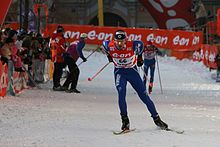
Skate skiing is a technique in cross-country skiing where the leg kick is made using the skating step. This style has been established as a revolutionary development of cross-country skiing since the mid-1980s and allows faster movement compared to the normal style. Since 1985, international competitions have been held separately for classic and skating.

In contrast to classic skiing, skating skis can be fully optimized for gliding and do not need a grip zone in the center. The skis are typically slightly shorter, while the poles used are slightly longer. Although there are skis designed to accommodate both classic and skating techniques as a compromise, recreational skiers generally use separate equipment for each. Unlike classic trails, skating trails are not groomed but are simply rolled to a sufficient width, providing less lateral stability for the skis. Skating technique is considered more challenging to learn[1] and more physically demanding, especially on climbs, where even the slowest pace requires significant energy.[2] To train for skating during the summer, athletes use roller skis or engage in other activities related to inline skating, particularly those focused on performance.[3]